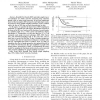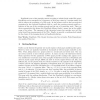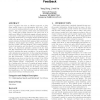180 search results - page 23 / 36 » Learning random walks to rank nodes in graphs |
ICDM
2005
IEEE
14 years 1 months ago
2005
IEEE
Many real applications can be modeled using bipartite graphs, such as users vs. files in a P2P system, traders vs. stocks in a financial trading system, conferences vs. authors ...
CORR
2010
Springer
13 years 7 months ago
2010
Springer
Abstract--Breadth First Search (BFS) and other graph traversal techniques are widely used for measuring large unknown graphs, such as online social networks. It has been empiricall...
ICML
2003
IEEE
14 years 8 months ago
2003
IEEE
A new kernel function between two labeled graphs is presented. Feature vectors are defined as the counts of label paths produced by random walks on graphs. The kernel computation ...
IM
2007
13 years 7 months ago
2007
PageRank is one of the principle criteria according to which Google ranks Web pages. PageRank can be interpreted as a frequency of Web page visits by a random surfer and thus it r...
WWW
2010
ACM
14 years 2 months ago
2010
ACM
Query suggestion has been an effective approach to help users narrow down to the information they need. However, most of existing studies focused on only popular/head queries. Si...



